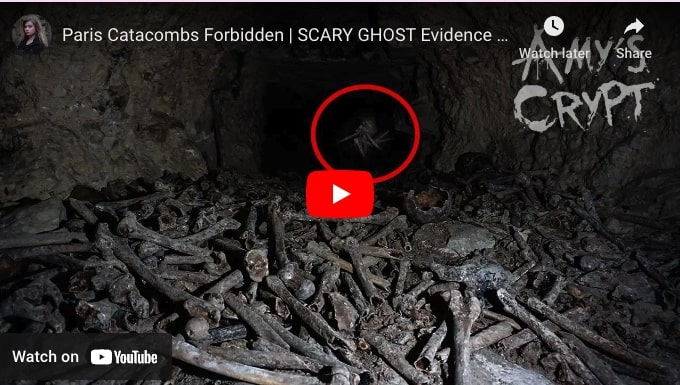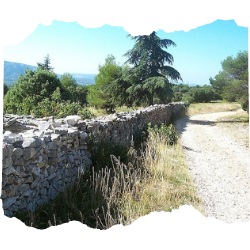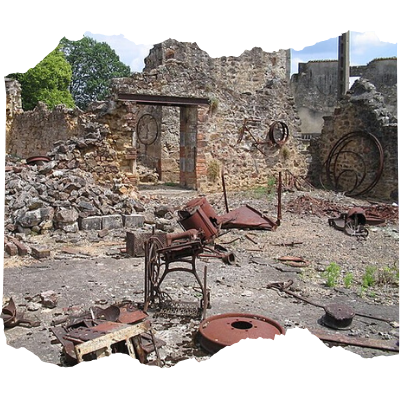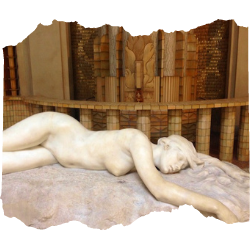Unsure about your French table manners? Click Here to download > > How to avoid these 10 food etiquette mistakes !
- Home ›
- Destinations ›
- Paris ›
- Haunted Catacombs
Haunted Catacombs Of Paris: How To Explore The World's Largest Grave
Updated 24 June 2023 by Leyla Alyanak — Parisian by birth, Lyonnaise by adoption, historian by passion
NOTE: THE CATACOMBS ARE CLOSED FOR RENOVATIONS UNTIL MAY 2026
Ready to explore the haunted Catacombs of Paris? I felt a mixture of feelings when I visited, and I suspect you might feel the same.
Next time you take a stroll through the French capital, remember this: below you run many miles of underground tunnels, filled with the remains of six million people in their final resting place – the haunted Catacombs of Paris.
Experiencing a descent into the "Empire of Death" is one of those experiences that remain memorable far after they're over, and those of us who have visited the Catacombs usually recall the visit as one of the most intense places we visited in Paris.
Let's see how you feel about them!
Get more of the backstory on the Catacombs by booking a guided tour, or purchasing an in-depth audio guide.
NOTE: Pages on this site may contain affiliate links, which support this site. See full Privacy Policy here.
What are the Paris Catacombs?
This is an eerie place, one of the most haunted places in Paris.
You'll be thrilled by your visit if you're keen on the city's history, or interested in the potentially paranormal.
But you'll also relish the experience if you're simply looking for something fascinating when the weather is uncooperative, or if you're looking for an off-the-beaten-path discovery.
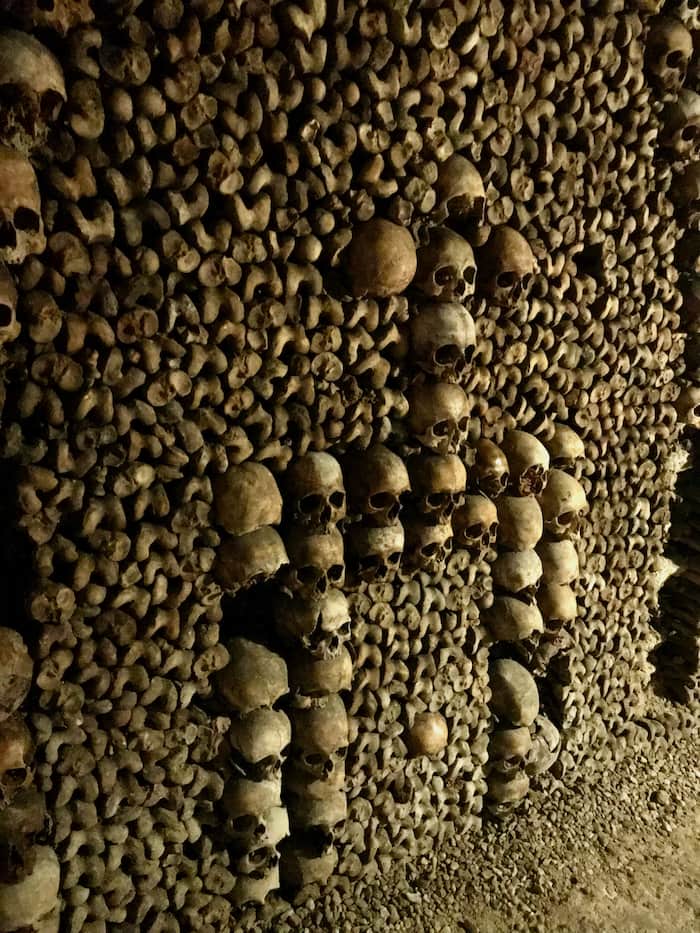 Skulls are positioned in many different ways in the Catacombs of Paris
Skulls are positioned in many different ways in the Catacombs of ParisThe Catacombs under Paris are by no means the only crypts or catacombs in the city – there are several others under churches and in cemeteries throughout Paris but the Catacombs are by far the largest.
Only a tiny portion of the underground is open to the public, but those tunnels that are accessible are well worth the visit, as long as you don't mind the dark, dank and potentially macabre.
And many people don't: for example, ghost tours in Paris (which often include the Catacombs) are a major tourist attraction, and most Paris Catacombs tours sell out quickly.
The Paris Catacombs are named after the Roman Catacombs, but it's a misnomer. Catacombs are underground cemeteries, with tombs where people are buried. An ossuary, on the other hand, is a room where human bones are stored, as opposed to a burial place. The Paris Catacombs are, in fact, a giant ossuary. Make sure you get your skip the line tickets before you go.
History of the Paris Catacombs
The Catacombs weren't always a refuge for the bones of dead people.
In Roman times, open-air quarries existed throughout the region, well beyond the city limits of what the Romans called Lutetia, long before it became the French capital.
People helped themselves to the stone, first for their humble dwellings, but once the Middle Ages rolled in, to build their huge cathedrals as well.
After all, why transport stone from far away when so much limestone could be found so easily just beneath their feet?
The city spread until it found itself right above the quarries, but constant excavations weakened the ground, creating an unregulated underground labyrinth that threatened to collapse.
Sometimes, it did, like the infamous 1777 collapse on the Rue d'Enfer, which swallowed up an entire house.
Worried about the ground under the city of Paris, authorities set up a General Inspectorate of Quarries (it still exists) to check on their stability and to prevent anyone from digging new ones.
Meantime, the city's cemeteries were filling up.
The city was expanding, population was growing, and the city's 200 graveyards could no longer keep up with the demand for space. Each time a new grave was dug, bones would be found underneath.
The sheer weight of all these bodies was straining the grave walls until finally, in 1780, an entire chunk of the Cimetière des Saints-Innocents, the largest in Paris, gave way, right into the basement of a local restaurant.
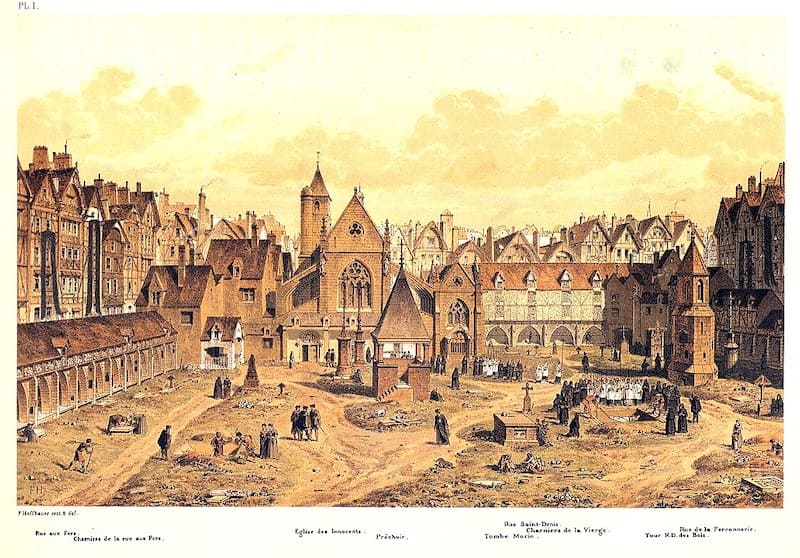 Saint Innocents cemetery in Paris, ca. 1550 by Theodor Josef Hubert Hoffbauer
Saint Innocents cemetery in Paris, ca. 1550 by Theodor Josef Hubert Hoffbauer☠️ PRO TIP: Get to know the catacombs with one of these top 5 Paris Catacombs tours
Collapse was not the only danger.
The entire setup was utterly insalubrious, the many mass graves becoming sources of infection and illness, smelling of putrefaction and polluting the wells from which people got their drinking water.
As the citizenry howled, Paris finally did something about the overflowing cemetery: it moved the buried remains to the former quarries of Tombe-Issoire, in what is now the 14th arrondissement. And that's how it all began.
The bones were carried in the dead of night to avoid scaring the city's respectable burghers. One can only imagine such a death procession, with priestly robes floating past by torchlight, accompanied by the squeal of heaving carts and the whispered blessings of the clergy as the cortège moved forward.
Transporting all the bones would eventually take a full 12 years...
QUICK TIMELINE OF THE CATACOMBS IN PARIS HISTORY
- 53 million years ago: Paris is a swamp
- 47 million years ago: the city begins to take shape, with rivers and banks
- 1st century CE: first open-air limestone pits
- 14th century: first underground quarries
- 1774: serious cave-in, 300 meters of the Paris tunnel system collapse
- 1776: Louis XIV bans mining under Paris
- 1777: creation of General Inspectorate of Quarries
- 1780: closure of Saints-Innocents cemetery
- 1786: municipal ossuary opens in former Tombe-Issoire quarry
- 1787-1814: more transfer of bones from local Paris cemeteries
- 1809: ossuary opens to the public
- 1860: last bones brought in after being uncovered during Haussmann's 18th-century overhaul of Paris
- 2002: Catacombs become part of the Musée Carnavalet (History of Paris)
- 2017-2019: new entrance and exit inaugurated
—Courtesy Catacombs of Paris
The first bones under Paris were moved in April 1786, and more would be added over time, as other cemeteries filled up. By 1814, when the limestone quarries finally closed, the miles of tunnels under Paris would be home to some six million souls.
They came to be known as the "Catacombs", in reference to the underground necropoles in Rome, although in Paris they were ossuaries rather than burial places. (Eventually, excavations during the 1960s would yield even more remains, which would also find their way here.)
The Paris Catacombs were opened to the public on 1 July 1809 with great fanfare, creating a stir among the glitterati who visited − these included such contemporary luminaries as Napoleon III and the Emperor of Austria.
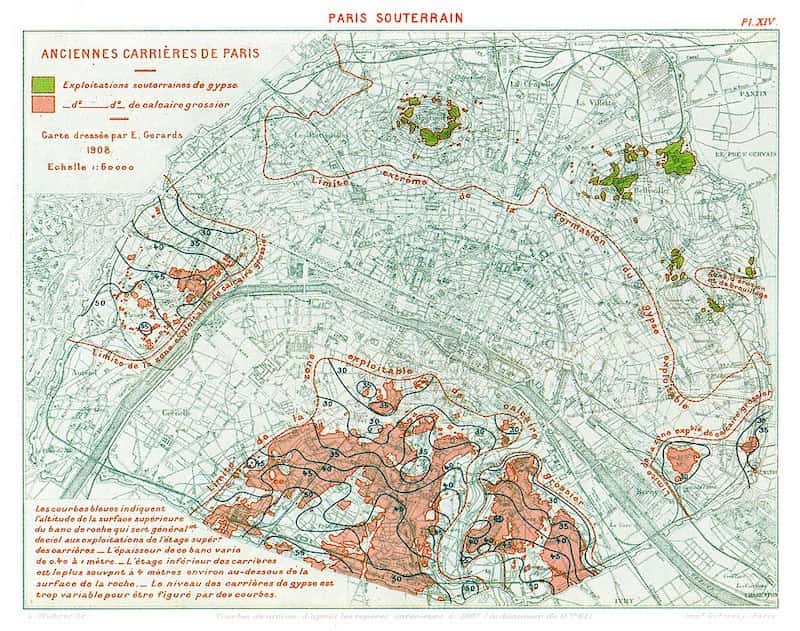 This isn't quite an official Catacombs in Paris map, but it does show you the areas where the mines were once located. Plan by Émile Gérards (1859–1920)
This isn't quite an official Catacombs in Paris map, but it does show you the areas where the mines were once located. Plan by Émile Gérards (1859–1920)Visiting the Catacombs of Paris
The section now open to the public is called the Ossuary of Denfert-Rochereau, across the street from the metro station of the same name. (Denfert-Rochereau, by the way, was a military leader who led the heroic resistance of the city of Belfort in 1871 during the Franco-Prussian War.)
No question: the haunted Catacombs of Paris are one of the more unusual places to see in Paris.
Scary Catacombs: Are the Paris Catacombs haunted?
It's a simple journey, beginning with a corkscrew stairway that plunges you 20 meters underground. There's no avoiding this – there are no elevators.
After looking around a well-lit room filled with information and displays, the hush begins. A pseudo-grand entrance leads you into the Catacombs with these words: "STOP: This is the Empire of Death."
Not discouraging, but not quite welcoming, either. They're not called the haunted Catacombs of Paris for nothing.
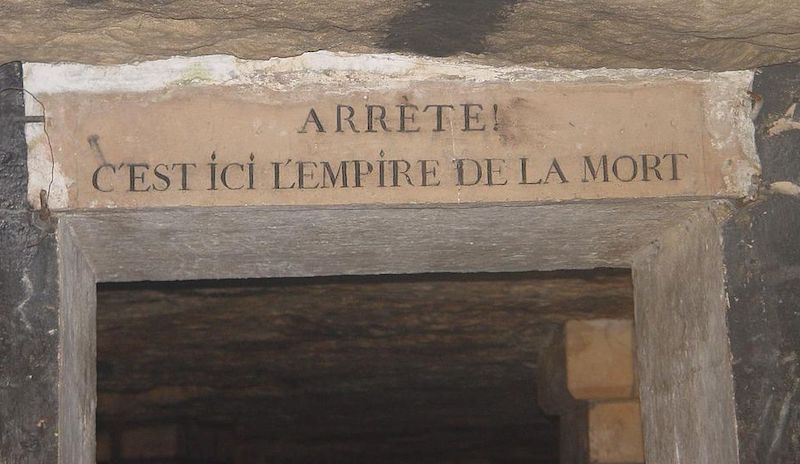 Catacombs entrance, Paris. The sign says: "STOP! You are entering the empire of death."
Catacombs entrance, Paris. The sign says: "STOP! You are entering the empire of death."Know that you'll be walking through lengthy dark tunnels of humid earth for quite a while before reaching the actual ossuary, so claustrophobes should abstain, as should those who have difficulty breathing.
As you advance, any noise will become more muted and muffled, enveloping you in the silence of the earth beneath. The path forward is relatively well marked, but don't wander off, because there is no phone signal down here and if you get lost...
One of the favorite urban legends concerns a certain Philibert Aspairt who wandered into the depths in 1793 but never found his way out (you can read more about him below).
Who knows if his ghost isn't still wandering around...
Bones as art
You'll see plenty of astonishing things: bones built up into unusual shapes and structures, signs with names of the streets above, small rooms with vaults...
Rather than the grim and gory scenes you might expect, the bones have been positioned to please, a decision made long ago by the then General Inspector of the Quarries, Louis-Étienne Héricart de Thury. He set up the bones as museum pieces, with spectacular architectural structures such as doric columns, commemorative plaques, altars – and unusually shaped structures, many of which are considered works of art.
Had he been at work today, some of the more whimsical constructions would not have been considered good taste by 21st century sensitivities.
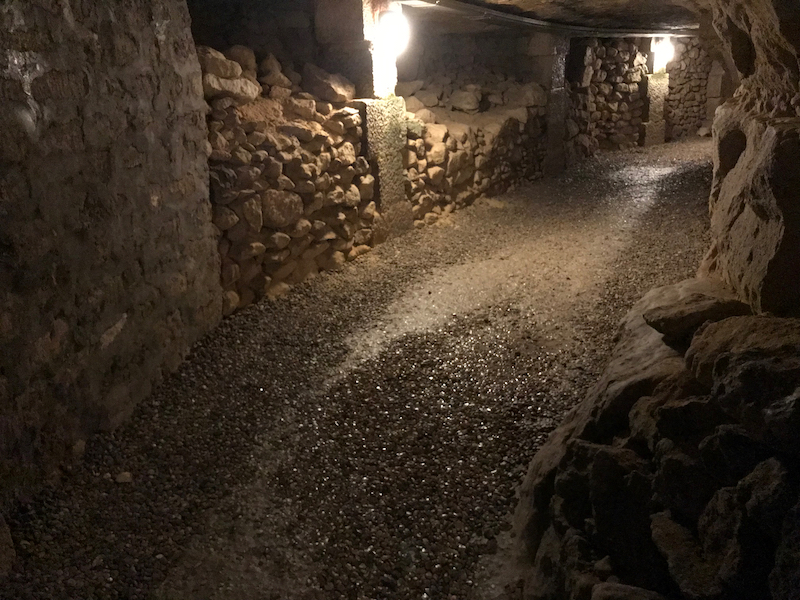 Cool and humid Paris Catacombs, bones piled up along every wall
Cool and humid Paris Catacombs, bones piled up along every wall Catacombs in Paris facts: the tunnels follow the streets of Paris, and there are plenty of clues as to which street or square you're under
Catacombs in Paris facts: the tunnels follow the streets of Paris, and there are plenty of clues as to which street or square you're under Interesting facts about the Catacombs in Paris: Catacombs art is actually a thing, and skulls were positioned to be aesthetic
Interesting facts about the Catacombs in Paris: Catacombs art is actually a thing, and skulls were positioned to be aestheticThe sculptures of the Catacombs
While much of what there is to see is made up of bones, I found several unexpected sculptures as I wandered through the tunnels, but I'll let you discover those for yourself.
There were also some I did not see, mostly carved in the late 18th century between 1777 and 1782 and hewn by a certain Décure, a quarry worker with the General Inspectorate.
A former army veteran, he had fought for the liberation (from the English) of Minorca, in the Balearic Islands, and was imprisoned at Port Mahon, the island's capital.
While working in the quarry, he discovered a cavern that had opened after a rockfall. At lunchtime, while his colleagues returned above ground for lunch, he would enter "his" cavern and chip away at the rock. For five years, he fashioned buildings underground that reminded him of those of Mahon.
Sadly, some of the wall sculptures were damaged during the French Revolution, which would break out shortly after his death, and, in later years, by nature and people, although much has been restored.
These "additional" caverns aren't always open to the public, although they do allow some visits on special occasions.
DON'T FORGET TO BUY YOUR PARIS TOURS AND TICKETS FOR THE CATACOMBS!
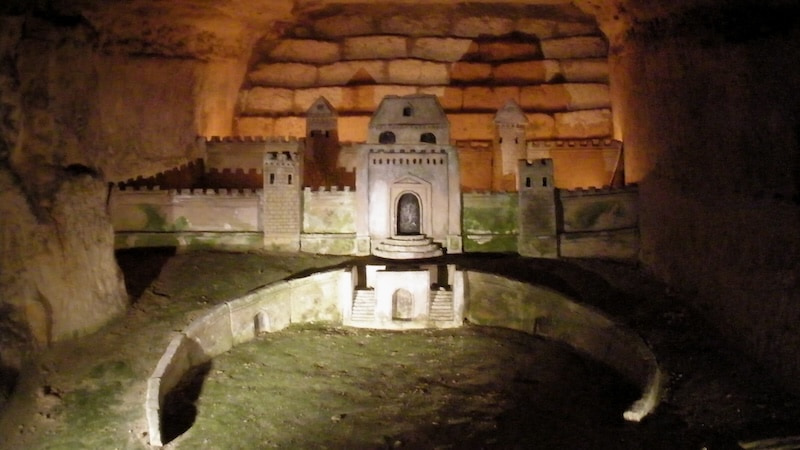 Port Mahon (Photo Nico Paix from Kent, OH, CC BY 2.0, via Wikimedia Commons)
Port Mahon (Photo Nico Paix from Kent, OH, CC BY 2.0, via Wikimedia Commons)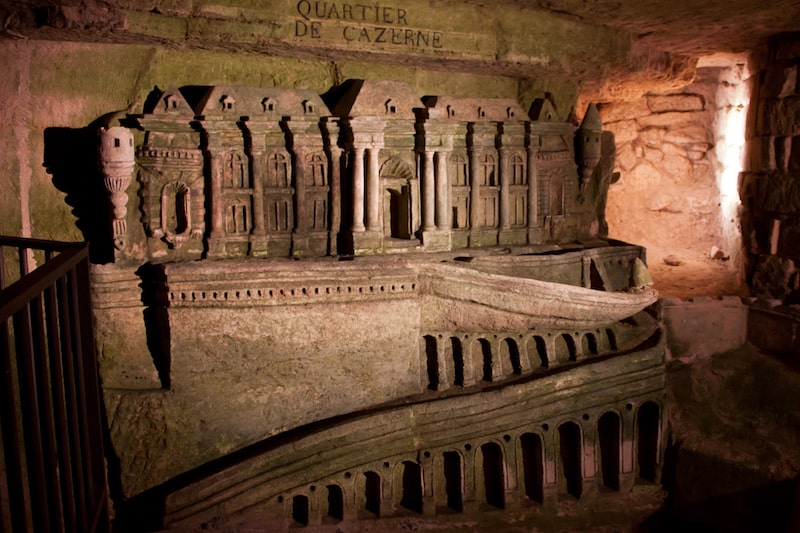 More sculptures to see when visiting the catacombs in Paris
More sculptures to see when visiting the catacombs in ParisLooking for other unusual places to visit in Paris? Places you may not know about?
7 Non-Touristy Things to Do in Paris
Is it legal to go into the Catacombs of Paris? Yes. And no.
Long before the Catacombs became commercialized, electrically lit and properly mapped, people wandered down here to explore these creepy places freely. Eventually, the Catacombs were partly cordoned off, with only a portion now available to visit.
Some people insist on going beyond these "permitted" areas, however. The taste of the forbidden is never far away...
The cataphiles of Paris
There are many Paris Catacombs stories, and with only a small portion of the tunnels open to the public, it is inevitable that adventurers will want to explore the rest and uncover their hidden stories.
Those who kept coming back are called cataphiles, passionate visitors of the forbidden underground, owners of the Parisian netherworld.
How cataphiles came about
People have been visiting the tunnels for centuries but wandering off without a guide or off the official paths has been illegal since 1955.
Many of these cataphiles became particularly active during the May 1968 street revolts, when students used the Catacombs to circumvent police barricades. By the 1980s, being a cataphile was often a lifestyle choice, with manholes almost turning into revolving doors, and some underground chambers so crowded their party music clashed with that of neighbouring tunnels.
Enough was enough, and authorities eventually sealed off most of the entrances. The number of cataphiles dwindled, and only the most passionate remained.
That said, the arrival of Covid-19 had an unexpected effect on the Catacombs: it encouraged illegal gatherings, where young people could get together away from prying eyes − and from curfews.
Now, however, police are back in full force and making sure no one wanders off the main paths.
THE FIRST CATAPHILE: PHILIBERT ASPAIRT
The doorkeeper of a military hospital, he is widely considered the first cataphile.
According to the story, he one day ended up in the quarries by following a stairway found in the courtyard. And he lost his way.
Eleven years later, he was found, identified by the keychain he carried on his belt, the most famous of the Paris Catacombs deaths.
Not everyone believes the story, but it does serve as a cautionary tale for those who would wander around unprepared.
Today, Philibert is widely considered the cataphile patron saint.
Being a cataphile is not risk-free
There's no question security is an issue.
The possibility of getting lost exists, of course, and there's no phone signal down there. But that's not all.
There be rats. Of course there are: we're underground! Rats carry diseases.
There are other possible dangers. The tunnels could flood – some are already half-full of water, or could cave in, because not all the tunnels have been reinforced. And you can't assume all cataphiles are friendly. In fact, some are downright sinister and muggings underground are not unknown.
Undeterred? Still want to go?
Tracking down a cataphile
To many cataphiles, tourists who simply want to experience the forbidden areas of the Catacombs as a bucket list item are cause for disdain.
But that doesn't mean you won't find someone to guide you.
Since this is an illegal endeavour, cataphiles willing to guide don't advertise. Fines have become stiffer and motion sensors make a visit riskier, so a cataphile might not necessarily be overjoyed to have some stranger tagging along.
You'll have to build a relationship first: they're guarded about their underground travels and a simple request for a guide might be ignored. Plus, they don't know you. You could be a serial killer, and who wants that kind of company deep underground, where not even text messages reach?
That said, there are plenty of sites dedicated to exploring the Catacombs, but they're all in French, so if you do speak the language, you'll probably find someone if you try. You can browse through the Twitter #cataphiles hashtags. There are forums (here's one) where you can talk to real cataphiles and, who knows, maybe convince one to take you down. There's also this listings page. But I have no idea whether you'll meet with success, and I don't encourage it.
Before you become a cataphile
If you get that far and actually connect with someone willing to take you down, you'll be instructed on what to wear (waterproof shoes, a flashlight, drinking water, food, a map if you can find one, candles...), where to meet, how to behave. Here's a brief survival guide, again, if you read French.
If you're curious about what's down there, this short YouTube video will give you a glimpse (and you might just change your mind).
Cataphiles and catacops
That's right! It's not what they're called but since 1980 a special police brigade has been patrolling the Catacombs, looking for... cataphiles, of course.
Several times a week, they head into the tunnels, hoping to dislodge a few insistent cataphiles in what often turns into an unofficial game of hide and seek.
They look for clues (they are police, after all) – these could be cigarette or marijuana butts, the smell of fresh paint from tags or wall art, the sound of distant music from an underground party, an empty can or bottle... and often, they find people and parties. One night, they stumbled upon an entire discotheque with 300 guests. They also seal off new entrances when they find them, and rescue the occasional lost soul who wandered down, thinking it would "be fun".
The fines can range from €60 into the thousands but the lowest fine is usually applied when no damage has been done. That said, patience is eroding and fines are creeping up.
It's a frustrating job because it's dangerous, it's wet and smelly, and spending hours at night under those conditions may be fun for cataphiles, but the police aren't amused. Not to mention the menacing tags they sometimes find scrawled on the walls about an unwelcome police presence.
Even the police don't know their way around it all: in 2004, they discovered a motion-sensor recording of dogs barking, designed to keep people away, along with a huge cavern equipped as a cinema, with a bar and restaurant next door (along with phone and electrical installations). When they returned a few days later with electricians, everything had been disconnected and a note left behind: "Do not try to find us."
And while their primary job is finding illegal visitors, they have another job: they check on the tunnels themselves, to make sure nothing has shifted or is in danger of collapse, a quick spot-check brigade whose eye can help spot trouble before it happens.
Haunted Catacombs of Paris: the legend of the cat skulls
Let's leave the cataphiles and focus on the cats.
Many Paris Catacombs legends may be true, or not, but the story of the cats' skulls is guaranteed to give you chills. It is to be found in a book about underground Paris, which revealed an 1896 discovery of hundreds of skulls in the tunnels. Cat skulls.
It seems the Catacombs shared a well with a nearby restaurant, undoubtedly run by an unscrupulous manager who passed off felines as rabbits, their taste apparently similar.
This being an unacceptable practice, disposing of cat carcasses in the well isn't, well, inconceivable. Yet another of the creepy stories are told about the Catacombs...
A CATAPHILE ADVENTURE
This video documents a foray into the forbidden Catacombs of Paris. It's not something I recommend, but you can see for yourself...
The hidden uses of the Catacombs
As cataphiles became familiar with the tunnels, they often returned to the same rooms and eventually made themselves at home, decorating walls, bringing down furniture, adding street art to the walls and naming their secret rooms according to purpose or decor − La Plage (the beach), Le Cellier (the cellar) or La Salle du Chateau (the castle room).
The high-ceilinged "Room Z" may have been a gathering place for a right-wing splinter group in the 1930s, and was the scene of massive parties in the 1980s.
The Catacombs have been used to grow mushrooms, to meet for illicit sex, or even as nuclear shelters. During World War II, the Germans built a bunker down there, complete with electricity, reinforced doors and toilets. And until the 1970s, a mass was celebrated down here each year for the Day of the Dead.
Sadly, the Catacombs are not immune to vandalism and regular clean-ups are needed to get rid of the worst messes. A few years ago, vandals caused much destruction several months were needed for repairs.
A few scary facts about the Catacombs of Paris
- The tunnels run some 250-300 km (155-186 mi) under Paris. The ossuary, the part where the bones are kept, accounts for some 1.7 km (1 mile). The passageway is about 1.8m high (6 ft), although I'd quibble about this in some parts, where I was sure I could feel the ceiling not far above my head. The temperature is a uniform 14℃ (57℉) so don't forget your sweater.
- The tunnels are well lit but I felt better having a flashlight. What if there was a power failure? (Here's the one I ues.)
- Good walking shoes are a must, not only for the stairs but because of the humidity on the ground.
- People actually try to steal some of the bones, despite a video camera on almost every corner throughout the Catacombs.
- Did you know there's a Catacombs Paris movie? It's called As Above, So Below, and is a Blair Witch-type shoot of a trip down below. It tells catacombs horror stories so no, I haven't seen it.
- You can visit the Catacombs of Paris on your own or with an audio guide. Frankly, I didn't find the audioguide particularly helpful, although it did point out one or two things I might have missed otherwise − at 5 euros for the guide, we're looking at 2.5 € per fact, added to the steep entrance fee. (Click here to get your tickets for Catacombs Paris.) If you'd rather be with a smaller group, this Paris Catacombs tour might be the answer.
- This is also one of the fun things to do in Paris with kids! While there's no minimum age limit, it's not recommended for children under 10.
BOOKS YOU MIGHT ENJOY
- The Catacombs of Paris by Charles River Editors
- World's Scariest Places by Jeremy Bates (several volumes)
- Seven Ages of Paris by Alistair Horne
Haunted Paris Catacombs: FAQ
What are the Catacombs in Paris?
What are the Catacombs in Paris?
The Catacombs are an ossuary, an underground cemetery, built inside tunnels beneath the streets of Paris.
Are the Catacombs accessible for wheelchairs?
Are the Catacombs accessible for wheelchairs?
No they are not. There's a spiral staircase to go down, and then you'll have to come up at the other end – there is no elevator. Also, if you suffer from claustrophobia or have difficulty breathing, this is probably not a place you should visit.
Where are the Catacombs in Paris?
Where are the Catacombs in Paris?
The Paris Catacombs are located at 1 Av. du Colonel Henri Rol-Tanguy in the 14th arrondissement, or district, of Paris, across the street from the Metro Denfert-Rochereau.
Why are there Catacombs in Paris? And why were the Catacombs built?
Why are there Catacombs in Paris? And why were the Catacombs built?
The Catacombs are former quarries, which were transformed into ossuaries when the city's cemeteries became too full.
When were the Paris Catacombs built?
When were the Paris Catacombs built?
The quarries have been here for centuries, but were only used to house human remains beginning in 1786, when the first bones were moved here.
Who built the Paris Catacombs?
Who built the Paris Catacombs?
The quarries date back to Gallo-Roman times, but the actual Catacombs were developed by the French government in the late 18th century.
How deep are the Paris Catacombs?
How deep are the Paris Catacombs?
The Catacombs are located 20 meters / 65 feet underground.
How long are the Paris Catacombs?
How long are the Paris Catacombs?
While the tunnels as a whole are about 250-300 km (155-186 miles) long, the actual Catacombs you can visit are only 1.7 km (1 mile) long.
How many bodies are in the Paris Catacombs?
How many bodies are in the Paris Catacombs?
The Catacombs house the remains of six million Parisians.
Are the Catacombs haunted?
Are the Catacombs haunted?
Let me put it this way: six million bodies are stored here. If you believe in such things, that must also mean six million souls... surely a few of them are still wandering around the tunnels?
Are the Catacombs scary?
Are the Catacombs scary?
Not at all. Of course the presence of so many skulls and whatever lingers from that many lives might affect you but there's nothing scary about the Parisian Catacombs themselves.
Have the Paris Catacombs been fully explored?
Have the Paris Catacombs been fully explored?
Certainly not. They are huge, some areas are impassable, and there is no real original map of the Paris Catacombs.
Are the Paris Catacombs dangerous?
Are the Paris Catacombs dangerous?
Not at all, at least not the "official" Catacombs, those open to the public. The only difficulties are the spiral entrance stairway, and the long, dark hallways, which could be difficult for people who have problems with small spaces.
Are the Catacombs in Paris open?
Are the Catacombs in Paris open?
Yes, every day but Monday, from 10 a.m. to 8:30 p.m., with the last entry at 7:30 p.m.
Before you go...
If you enjoy the eerie side of Paris, places that give you a bit of a shiver, then make sure you read my story on the most haunted places in Paris, sure to hook you and reel you in!
Essential resources for your Paris trip
BOOK YOUR ACCOMMODATIONS
I use booking.com, because they include both hotels and holiday rentals like Airbnb or VRBO, so a wider choice and an easy cancellation policy.
DO YOU NEED A SIM CARD FOR FRANCE?
If you haven't signed up for a roaming service back home and have an unlocked phone, consider getting an e-SIM for France. Here's the one I use when I travel.
IF YOU'D LIKE TO READ UP ABOUT PARIS AND FRANCE
Drop by my long list of books about France, written by French or foreign Francophile authors, with plenty specifically about Paris.
AND DON'T FORGET YOUR GUIDEBOOKS!
➽ Lonely Planet's Paris Travel Guide
➽ Rick Steves' Paris
➽ Paris in Stride - An Insider's Walking Guide
A FEW WORDS ABOUT SAFETY
Paris is as safe as any major European city but you WILL find pickpockets in Paris. I keep them at bay by using a comfy anti-theft purse or an infinity scarf with a zipper to hide my cards and money.
Did you enjoy this article? I'd love if you shared it!
You might also like these stories!
Pin these and save for later!


